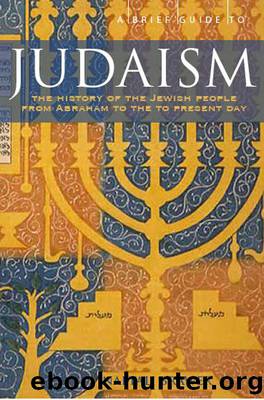A Brief Guide to Judaism by Naftali Brawer

Author:Naftali Brawer
Language: eng
Format: epub
ISBN: 9781472107565
Publisher: Little, Brown Book Group
One of these students, was Rabbi Shneur Zalman of Liadi (1745â1812), known as Rashaz. He was already a most accomplished Talmud scholar, halachist and Kabbalist when he arrived at Mezrich. After the Maggidâs death RSZ developed his own particular brand of Hasidism which he called HaBaD. HaBaD is an acronym for Hochma, Bina, Daâat, which means wisdom, knowledge and understanding. According to RSZ it is not possible to develop a deep and sustained love for God unless it begins with the intellect.
RSZ taught that emotions can be misleading and, more importantly, fleeting. Even the belief in feeling very strongly about loving God is probably just a self-delusion. The proof is that the feeling cannot be sustained for any lengthy period of time. A Hasid may feel ecstatic in the presence of his master but the feeling is lost once he leaves his masterâs presence. It may be possible to feel love for God during a particularly moving prayer, but once the prayer is over the love invariably loses its intensity. The solution to this, argued RSZ, is for the emotions to be rooted in the intellect. But how does one contemplate the greatness and glory of God? How does one even begin to frame such thoughts? To this RSZ provides a solution, his theological works. He began to teach and disseminate his thoughts about theology and the Kabbala that had previously been within the purview of a select few. He believed that if only such powerful ideas were in the hands of the masses they would be able to use them in contemplating the greatness of God, leading them to a deep and sustained love of God.
This radical idea drew considerable criticism from his colleagues in the holy fraternity. Their criticism was based on two points. First, how could RSZ doubt the sincerity of the ecstatic Hasid who feels love for God? Second, how could RSZ have the audacity to disseminate to the masses the deepest teachings of Jewish mysticism? The masses do not need mystical ideas, argued one of RSZâs most outspoken critics, Rabbi Abraham Kalisher. What they need is a Rebbe who will inspire them. It is enough for the Rebbe to study such mystical texts: he will in turn inspire the Hasidim. RSZâs response to this criticism was that the job of a Rebbe is not to serve as the source of a Hasidâs inspiration, it is to give the Hasid the intellectual tools so that he can achieve inspiration on his own. With neither side backing down, a creative schism developed in the movement, differentiating the intellectual Hasidut of RSZ (HaBaD) from the emotional Hasidut of his critics, called HaGaT (an acronym for Hesed Gevurah Tiferet; primary emotions).
One of the areas of distinction between the two schools of Hasidut is apparent in prayer. HaGaT Hasidim tend to engage in what can be described as ecstatic prayer. This includes lots of singing and shouting, accompanied by vigorous swaying and erratic body movements. HaBaD prayer is very different,
Download
This site does not store any files on its server. We only index and link to content provided by other sites. Please contact the content providers to delete copyright contents if any and email us, we'll remove relevant links or contents immediately.
| Haggadah | Hasidism |
| History | Holidays |
| Jewish Life | Kabbalah & Mysticism |
| Law | Movements |
| Prayerbooks | Sacred Writings |
| Sermons | Theology |
| Women & Judaism |
Man's Search for Meaning by Viktor E. Frankl(2264)
The Secret Power of Speaking God's Word by Joyce Meyer(2258)
Mckeown, Greg - Essentialism: The Disciplined Pursuit of Less by Mckeown Greg(2117)
MOSES THE EGYPTIAN by Jan Assmann(1977)
Unbound by Arlene Stein(1945)
Devil, The by Almond Philip C(1906)
The Complete Dead Sea Scrolls in English (7th Edition) (Penguin Classics) by Geza Vermes(1845)
I Capture the Castle by Dodie Smith(1576)
Schindler's Ark by Thomas Keneally(1517)
The Invisible Wall by Harry Bernstein(1463)
The Gnostic Gospel of St. Thomas by Tau Malachi(1414)
The Bible Doesn't Say That by Dr. Joel M. Hoffman(1374)
The Secret Doctrine of the Kabbalah by Leonora Leet(1271)
The Jewish State by Theodor Herzl(1255)
The Book of Separation by Tova Mirvis(1227)
A History of the Jews by Max I. Dimont(1212)
The Dead Sea Scrolls Bible by Martin G. Abegg(1203)
Political Theology by Carl Schmitt(1189)
Oy!: The Ultimate Book of Jewish Jokes by David Minkoff(1107)
